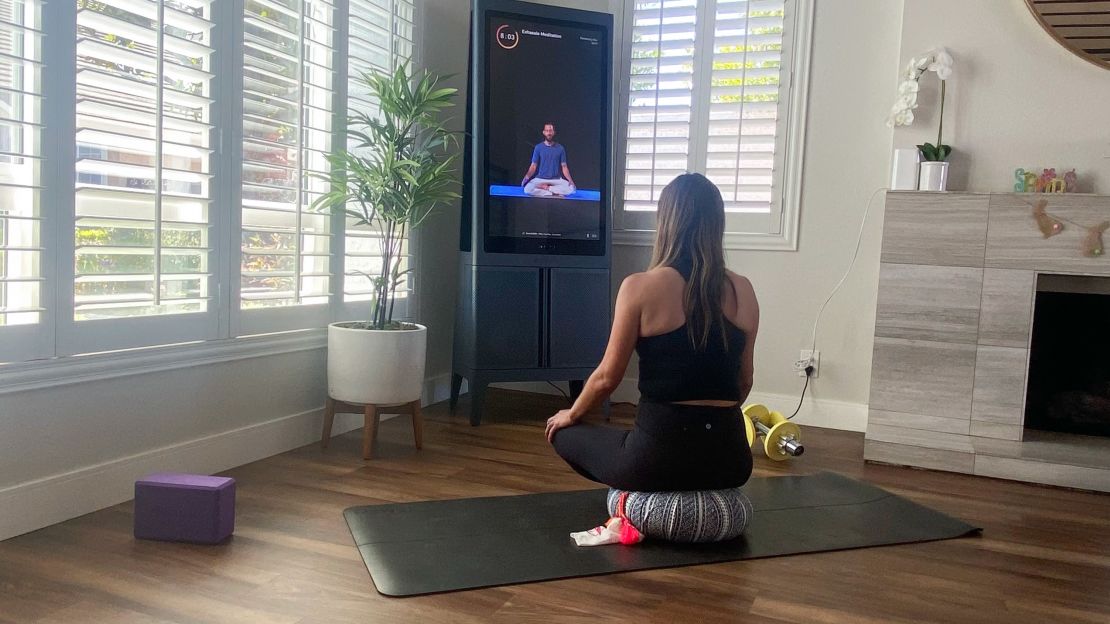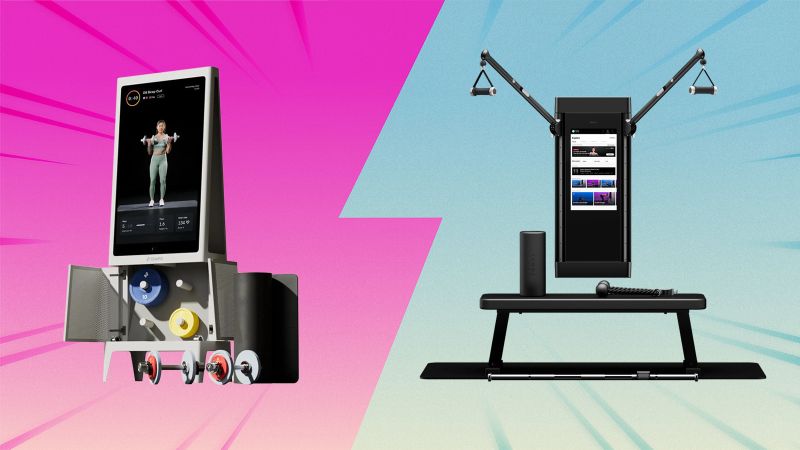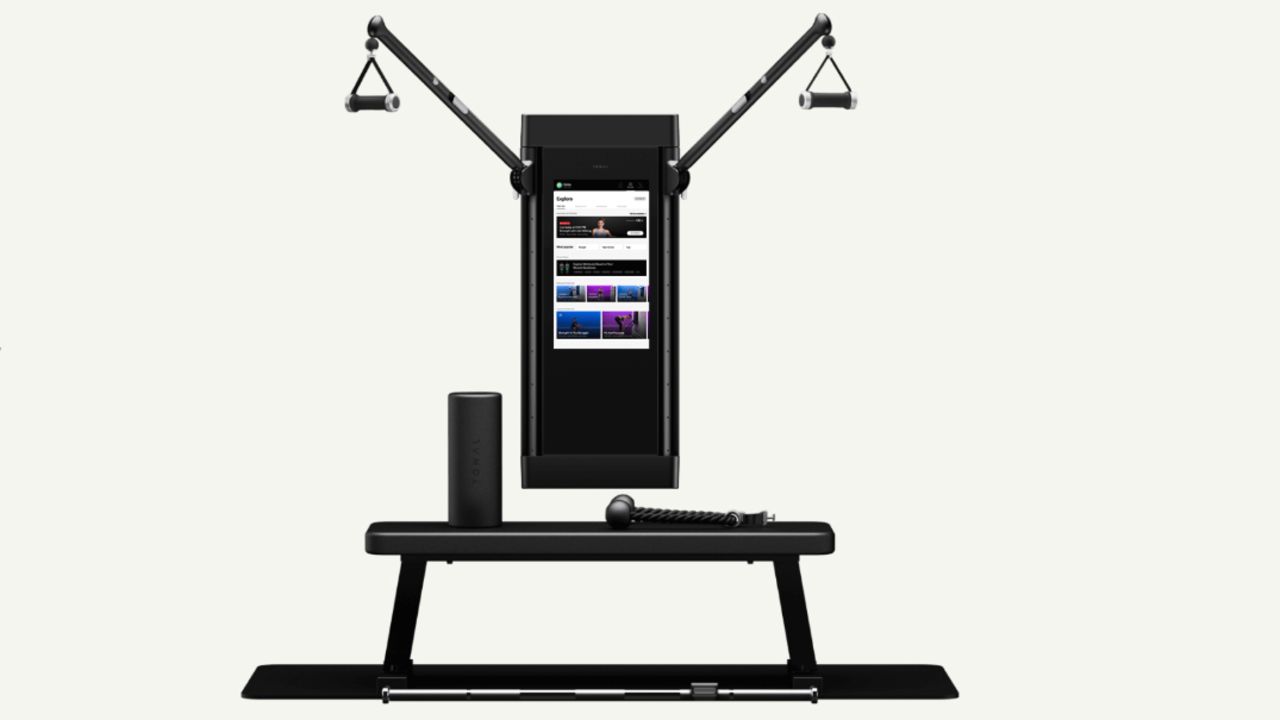This article is part of our series Battle of the Brands, in which we compare category-leading products to their counterparts to determine which are actually worth your money.
Remember when building a home gym meant allocating an entire room to an array of bulky equipment? You’d have to consider investing in an exercise bike, treadmill or elliptical — then throw in things like a weight bench, free weights and a yoga mat to make sure you were guaranteed a good sweat. Maybe you’d even install a big-screen TV to watch your favorite YouTube classes or mirror your smartphone. Thankfully, times have changed with the recent surge of space-saving, tech-savvy systems crowding the fitness market — and two of the most popular options also happen to be all-in-one, screen-based smart gyms
The pricier Tonal and slightly less expensive Tempo Studio both have high-tech features with WiFi, Bluetooth and AI technology. And both offer a wide variety of on-demand and live classes. That said, there are still plenty of differences between the two machines, most notably their size and design, as well as the level of interaction they provide to help you stay motivated.
We spent several weeks testing both to see which smart gym gave us the best workout. After countless hours of lifting, meditating, yoga and more, here’s the breakdown of how we chose our winner.
Tempo’s sleek A-frame design is a great option for apartment dwellers who wants a budget-friendly smart gym that doesn’t require them to mount any equipment on their walls.
This versatile smart gym includes countless programs, top-notch instructors and up to 200 pounds of digital weight.
|
Tempo Studio |
Tonal Home Gym |
|
|---|---|---|
| Subscription fee |
$39/month |
$60/month |
| Colors |
White, black |
Black |
| Weight |
100 lbs. (without plates) |
150 lbs. |
| Dimensions |
26 x 72 x 15 in. |
21.5 x 50.9 x 5.25 in. |
| Installation |
Free with purchase |
$295 to $495 |

Let’s be clear, both of these home gym systems are great for smaller spaces. Yet one of the biggest differences between the Tempo Studio and Tonal is Tonal’s slimmer design. The Tonal is mounted on your wall so it doesn’t require any extra floor space, unlike the Tempo Studio, which is built into a large A-frame weight cabinet. This means you can easily fit the Tonal anywhere in your home, as long as you have access to WiFi. This is a huge bonus if you’re working out in a shared space like your living room or home office, where the majority of the room is already filled with furniture.
The entire Tonal is about the size of a large mirror, yet has the ability to deliver up to 200 pounds of digital weight. However, because there are no free weights, just cables, it’s extremely easy to store anywhere in your house. The Tempo, on the other hand, is bulkier since it uses Olympic steel weight plates and dumbbells, which are housed in a sleek-looking cabinet below the screen. To compare, the Tempo measures 6 feet tall and 2 feet 2 inches wide, while the Tonal is 4 feet by 2 inches tall and 1 foot by 9 inches wide (though you can also get the smaller, less tech-heavy Tempo Move for a fraction of the cost).
TL;DR: Don’t have a ton of space? Tonal is significantly less bulky and can fit in any room with the footprint of about a full-length mirror while offering up to 200 pounds of digital weight. Tempo Studio is built into a cabinet and comes with physical weights and dumbbells.

Although we love the Tonal’s compact size, one big drawback is that it needs to be mounted on your wall. So, if you rent a house or apartment, the Tempo Studio is a safer choice. Unlike Tonal, the Tempo comes with an easel-style stand, which means there’s no drilling or drywall required. Set-up is much simpler, unlike the Tonal, which requires professional installation ($295 to $495) or the warranty is void.
The Tempo Studio is also easier to move, whereas the Tonal has more stringent requirements on where it can be placed in your home. Both machines require a strong WiFi signal, but you also need a minimum of three feet of wall space on each side of the Tonal, a power outlet within six feet of your workout area, drywall with metal or wood studs and a ceiling height of at least 7 feet so the adjustable arms can fully extend. And, if you ever move, you’ll need to hire Tonal’s installers a second time and pay an additional $300 for a relocation kit or, once again, the warranty won’t be viable.
Tempo, however, includes professional installation with every purchase. It can also be set up anywhere with access to a strong WiFi signal, a power outlet and enough room to stand six feet from the screen so the machine’s 3D sensors can detect your motion for real-time form feedback. Because it has more relaxed requirements than the Tonal, Tempo is definitely a better fit for apartment dwellers.
TL;DR: The Tempo may have a larger footprint, but it’s a better choice for anyone who rents their home. It’s easier to set up, with professional installation included in the price, and there’s no drilling or drywall required. The Tonal must be professionally mounted on the wall by the company’s approved installers, or your warranty will be void.

If you’ve never lifted before, the Tempo has a much steeper learning curve for beginners. Although there are several 5- to 10-minute tutorials in the on-demand library, learning how to load your weights can be confusing and, at times, time-consuming. You will eventually get the hang of it, but it may take several classes — and a lot of frustration — before you can change the weight plates as fast as your instructors.
The Tonal, on the other hand, does all of the hard work for you. After an initial strength assessment, the machine determines how much digital weight you can handle. It then increases that number throughout your fitness journey. As you continue to get stronger, your weights will automatically get heavier. If you’re lifting too heavy, the machine will also lighten your load using its AI technology to monitor your progress.
Tonal’s initial strength assessment also demonstrates how to use each of the attachments that come with the machine, so you don’t need to learn as you go. The Tempo does demonstrate proper form for a few basic moves after your initial assessment, and it has cool features like rest intervals based on your heart rate (if you connect a heart monitor) and body composition scanning available on the digital app. However, the daily readiness score, which assesses how your body will perform on any given day, still mistakenly suggested weights that were too heavy for me during my first class, which made me feel discouraged and less like I was working with a virtual trainer than Tonal.
TL;DR: Tonal is just simpler to use. And though some people prefer Tempo’s “real” weights, Tonal’s form feedback is incredibly insightful. And being able to lift up to 200 pounds without switching any weight plates during your workout is a total game changer.

Although both machines are undeniably high-tech, the Tonal feels more intuitive for beginners to jump right into strength workouts than the Tempo Studio. You don’t need any background in weightlifting and it’s easy to keep up with the instructors simply by following the prompts on the screen.
Tonal’s form feedback was also clearer for me to understand. The messages keep reappearing on screen whenever you aren’t nailing your form, which means you have ample opportunity to fix your mistakes. Although Tempo also gives real-time prompts using its unique 3D motion sensors, these cues only appear once for each set, not repeatedly. So you could potentially keep making the same mistakes over and over again (like I did) without ever realizing you’re still using incorrect form.
Both machines count all of your reps for you and provide automatic tracking and real-time performance stats. Tempo also has a daily readiness score, but it isn’t always accurate based on my experience. There were multiple times it told me to go too light or too heavy while I was streaming classes. The digital app has some cool AI features like body composition scanning, resting heart rate and stress scores, but using the app isn’t always convenient while you’re working out.
There are also leaderboards for both machines to help keep you invested in your workout, but only Tonal has live interaction with other members. You can cheer them on and see their stats, while Tempo only lets you follow other Members on the leaderboard, so there’s no real connection to help you stay motivated.
In addition, Tonal offers several dynamic weightlifting options based on your preferences, including eccentric, chain and burnout modes. You can even choose a spotter mode if you’re brand-new to strength training or want to try lifting extra-heavy to ensure that you don’t put yourself at risk for an injury when you’re working out alone.
TL;DR: Tonal wins hands-down when it comes to interactive, intuitive features. We greatly appreciate its feedback and real-time prompts, which will better help you stay in good form, and we like that you can gain motivation through live interaction with online members.
Classes and instructors

Tempo Studio and Tonal both offer a wide variety of classes, including barre, Pilates, boxing, mobility, meditation and yoga. But the real emphasis for both machines is on strength training. This, in my opinion, is where Tonal shines. I found Tempo’s instructors a little too chatty and preferred the straightforward, extremely detail-oriented instruction I received from Tonal’s programs.
Although Tempo’s instructors were also likable and I was a big fan of their yoga, barre and meditation classes, I wish there were more demos for their strength classes. Instead, you need to take short tutorials if you really want to perfect your form, whereas Tonal’s instructors seemed to spend more time reinforcing how to do each move properly before starting each set.
Both machines offer plenty of programs based on your personal goals and preferences, as well as live and on-demand classes. There’s a huge catalog of streaming workouts, with more than enough options to adequately replace a gym membership. Subscribing to Tonal costs $60 a month for unlimited household memberships and is required for the first year of use, versus Tempo Studio, which is only $39 a month for up to five household profiles.
TL;DR: Tonal may have better strength training classes and more straight-forward instructors, but Tempo wins when it comes to your budget, offering a monthly subscription for $39 compared to $60 per month for Tonal.
Purchasing a smart gym is a big investment. If money is no object, the Tonal is undoubtedly the best choice. Yes, the Tempo Studio is significantly cheaper, with bundles ranging from $1,677 to $2,397. The Tonal, on the other hand, costs $3,995 and doesn’t even include professional installation, which is required for an extra fee.
One downside to both machines? You’ll need to purchase additional accessories if you want to access all their streaming content. Tempo comes with an exercise mat, steel weight plates and dumbbells and Tonal comes with one set of smart handles, but neither smart gym has enough accessories to ensure that you can do all of its classes.
In the end, however, the more expensive Tonal is the smart gym that makes strength training accessible to everyone. Not only does it have a sleek design, a wide variety of classes and top-notch instructors like P90X star Tony Horton, but it provides enough digital weight to accommodate both beginners and experienced lifters alike. Although it’s got a hefty price tag, we think it’s worth the investment for anybody looking to replace their brick-and-mortar gym membership.











